Are there snake-infested rivers in North Carolina? Perhaps. But, before we get into which rivers the most snakes are slithering in and around, let’s discuss what “infested” means.
First, there’s no scientific scale that determines a level of infestation for snakes — it’s purely subjective! So, if you are afraid of snakes, snake-infested means something different than it does someone who studies these legless reptiles!
One thing to remember is you probably won’t even see snakes unless you’re looking for them. They have zero interest in battling you; snakes are smaller and almost always lose a fight with a human.
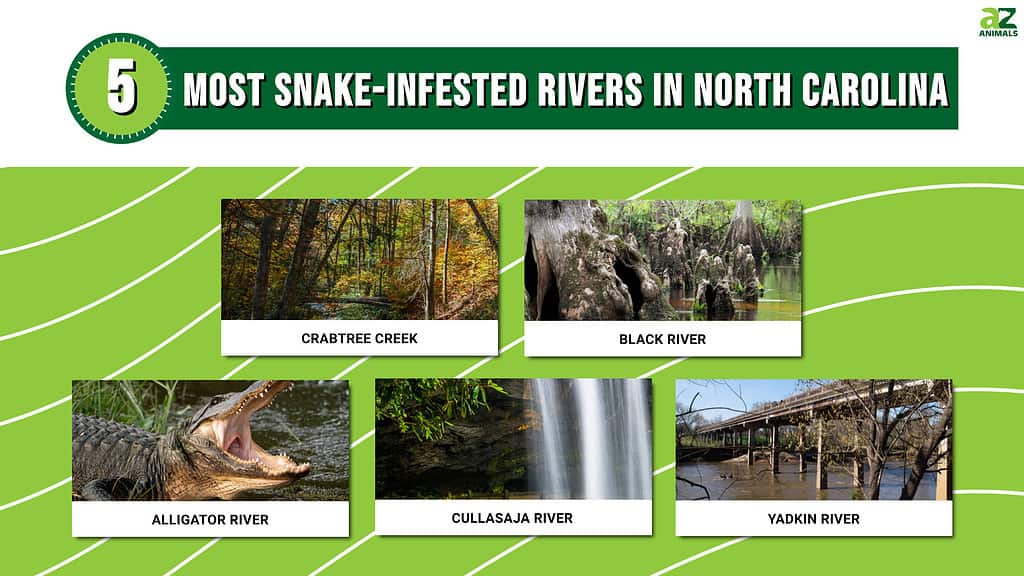
Water Snakes in North Carolina Rivers
All snakes can swim — venomous or nonvenomous; it doesn’t matter. Some species are more likely to slither into the water to cool off or escape predators, and others spend hours of each day in and around the water.
North Carolina’s 37 snake species include one venomous semiaquatic snake and over a dozen harmless water-loving species. Most of these are water snakes in the Nerodia genus, but there are also garter snakes, mud snakes, and rainbow snakes.
Here are the most common snakes “infesting” North Carolina rivers:
- Common watersnake (Nerodia sipedon) — widespread across the state
- Common garter snake (Thamnophis sirtalis) — widespread
- Plain-bellied watersnake (Nerodia erythrogaster) — common in eastern North Carolina
- Banded watersnake (Nerodia fasciata) — eastern North Carolina
- Queensnake (Regina septemvittata) — eastern North Carolina
- Brown watersnake (Nerodia taxispilota) — eastern North Carolina
- Mudsnake (Farancia abacura) — eastern North Carolina
- Crayfish snake (Liodytes rigida) — rare and usually only found along the coastal plains
- Rainbow snake (Farancia erytrogramma) — rare and only in eastern North Carolina
Except for the common watersnake, most of the Nerodia genus water snakes live in eastern North Carolina. While watersnakes are harmless, they’re not shy about defending themselves via biting. Trying to pick one up will leave you with bites that continue to bleed for a few minutes, thanks to a mild blood thinner in their saliva.
These fish and amphibian eaters often hunt in the shallows and bask on branches and rocks overlooking the river. Water snakes are more likely to duck under the water and swim that way than other snakes.

Northern watersnakes are the most common of all watersnake species.
©Patrick Coin / CC BY-SA 2.5 – License
Venomous Snakes Lurking in North Carolina Rivers
North Carolina has about six venomous snakes, from the incredibly rare eastern coral snake to the extremely common copperhead. However, you’re not likely to see copperheads in the water, but in the forested areas around it; coral snakes are so rare there aren’t any sightings listed in iNaturalist.org in the last several years.
Here are the snakes you’re most likely to see in or around North Carolina Rivers.
Cottonmouth (Agkistrodon piscivorus)
The only venomous semiaquatic snake that spends a lot of time in rivers of North Carolina is the cottonmouth. Also known as water moccasins, these dangerously venomous snakes have a bad reputation.
However, are they as terrifying as urban legends indicate?
Experts say they aren’t the aggressive human-chasing snake that local legends indicate. They’re pretty slow on the land. So, instead of making a quick escape, cottonmouths stand their ground. These snakes coil up and open their mouths wide, showing you their cotton-white mouth. If you push hard enough, they’ll strike with one of the fastest snake strike speeds in the world.
You only find cottonmouths in eastern North Carolina. They’re never far from water and are common in wetlands, marshes, and slower-moving rivers.
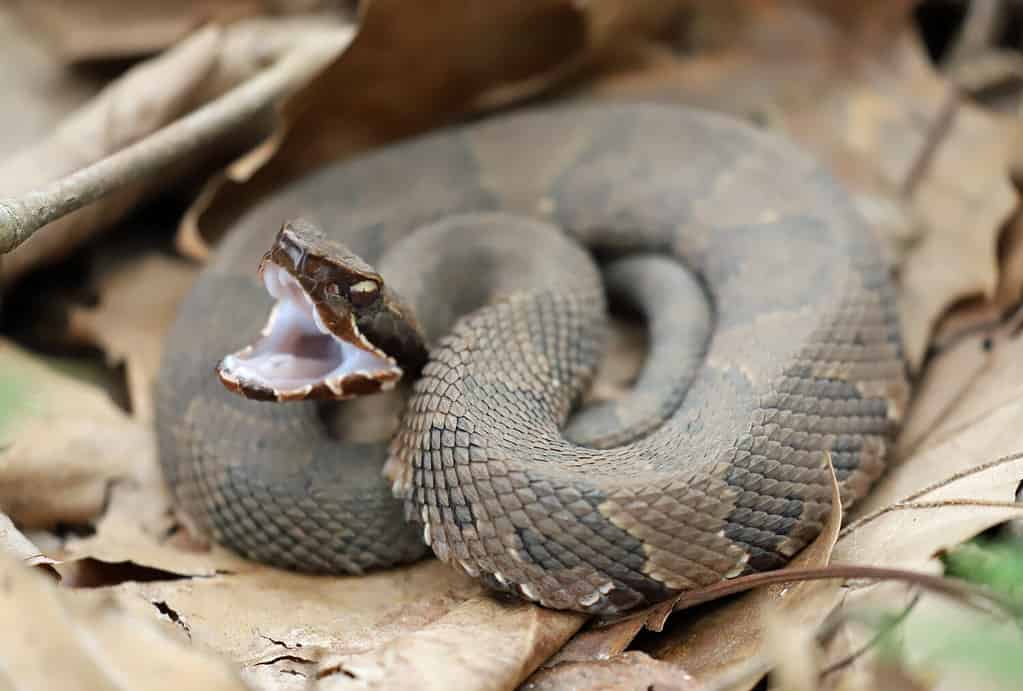
Cottonmouths only live in eastern North Carolina’s rivers.
©KF2017/Shutterstock.com
Pygmy Rattlesnake (Sistrurus miliarius)
These small rattlesnakes aren’t common. However, even where they have bigger populations, they’re so small that you may never see one. They sun themselves on the roads but also frequent marshes and the edges of rivers or lakes. Pygmy rattlesnakes are more likely to live in and around wet areas than other rattlesnakes.
Most pygmy rattlesnakes are reluctant to bite, but some individuals get a little snippy and strike repeatedly. It’s best to keep your distance if you spot one!
Other Venomous Snakes
- Copperheads (Agkistrodon contortrix) — not technically a water-loving snake but can be found in rivers across North Carolina on hot days.
- Timber rattlesnake (Crotalus horridus)
- Eastern diamondback rattlesnake (Crotalus adamanteus)
- Eastern coral snake (Micrurus fulvius)
Most Snake-Infested Rivers in North Carolina
Most of North Carolina’s watersnakes live in eastern North Carolina, except for the common watersnake, which is everywhere.
1. Crabtree Creek

Watersnakes, eastern ratsnakes, garter snakes, and copperheads live in and around North Carolina’s Crabtree Creek.
©Craig Zerbe/Shutterstock.com
Flowing through parts of Raleigh and a tributary of the Neuse River, Crabtree Creek is about 28 miles long and sits in the middle of a floodplain. Efforts to control flooding include lakes and flood-control dams, but it’s only partially effective. The result is a series of lakes with the river connecting them, giving smaller wildlife lots of room, food, and shelter.
Snakes you’ll find in and around Crabtree Creek include the ever-present common watersnakes, eastern ratsnakes, garter snakes, venomous copperheads, and if you’re lucky enough — you can see a queen snake or two.
2. Black River
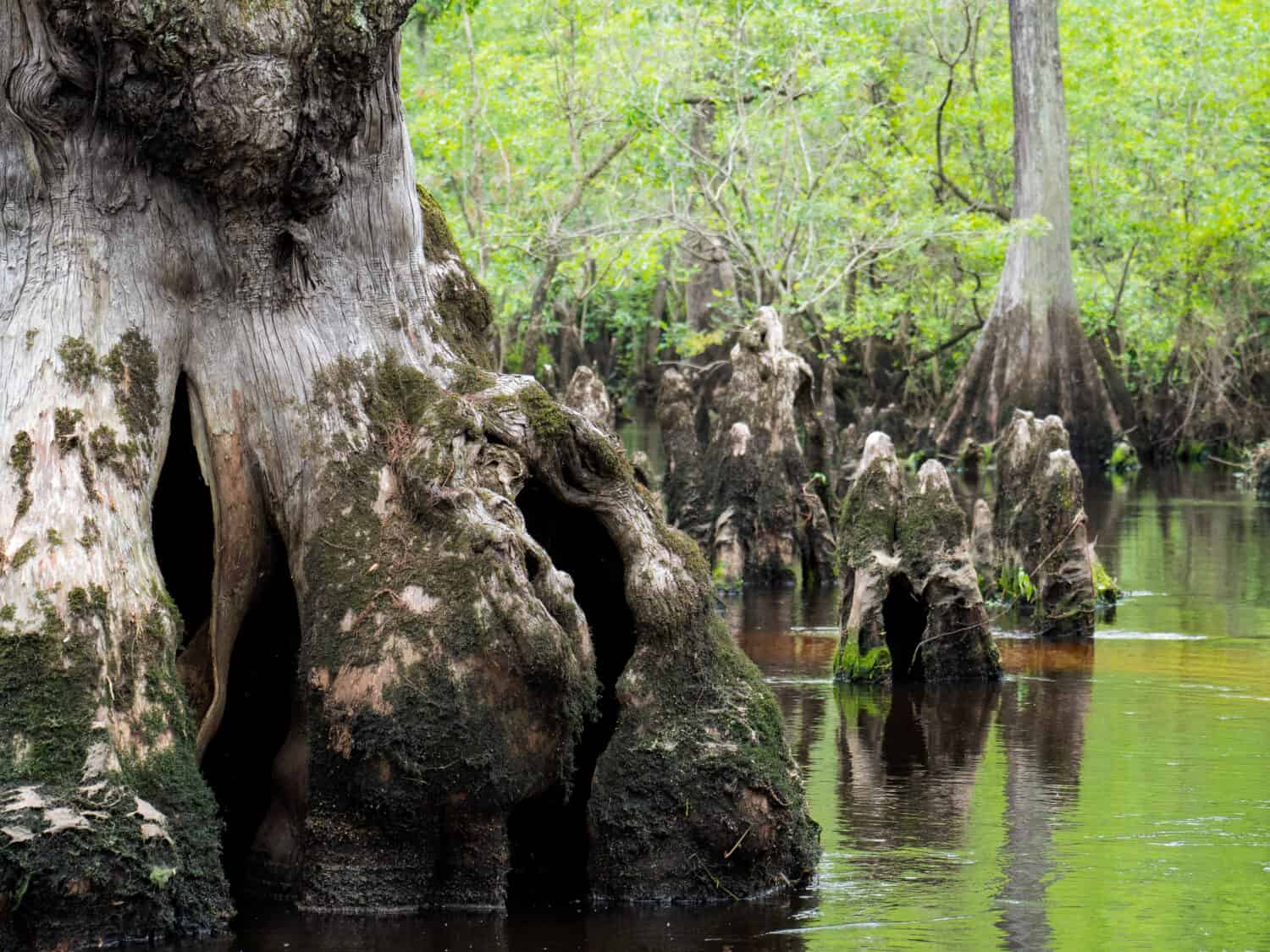
Just off the Black River is the Three Sisters Swamp, where ancient bald cypress trees grow.
©Coastal Girl/Shutterstock.com
This roughly 60-mile-long river, known for its ancient bald cypress trees, meanders slowly toward the Cape Fear River. It’s a slow-moving river home to the Three Sisters Swamp and lots of wildlife from the water to the trees! The Black River is popular for canoeing and kayaking but isn’t easy to navigate without a guide.
Snakes like cottonmouths, harmless-but-feisty brown, banded, and plain-bellied watersnakes are relatively common. Along the shoreline, you’re likely to see North American racers, eastern rat snakes, and venomous copperheads.
3. Alligator River
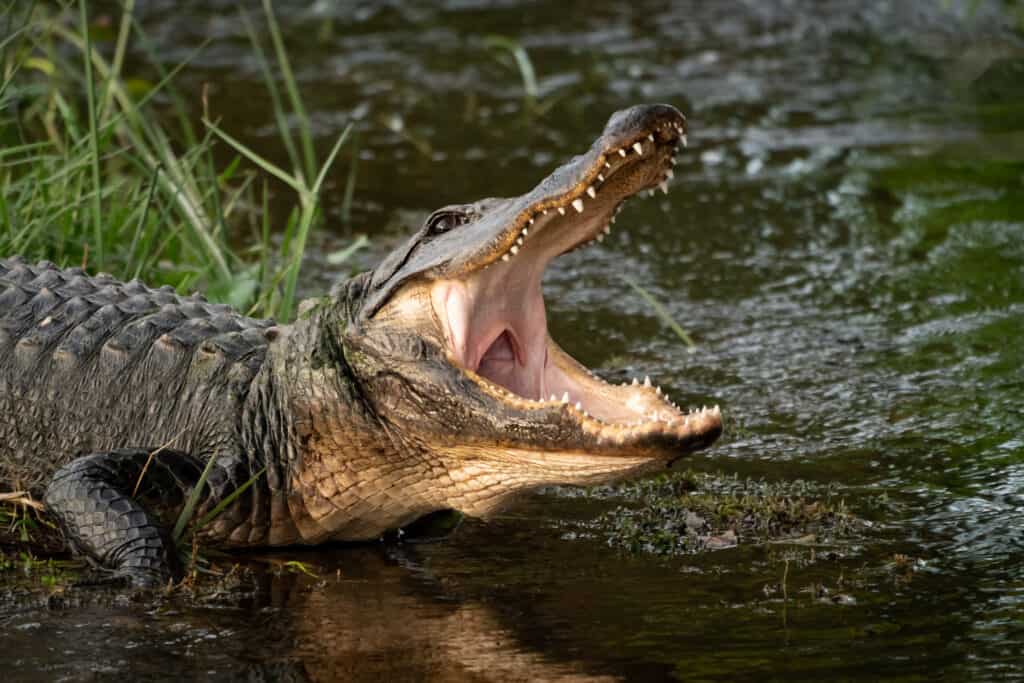
Even though it’s called the
alligator
river, it’s not full of them.
©Deborah Ferrin/Shutterstock.com
With a name like this, you expect it to be full of sneaky ‘gators waiting for you to slip up. However, it’s not so bad. There are some alligators, but it’s not overflowing with them. On the other hand, it’s popular for kayaking because it’s full of a variety of wildlife, including red wolves, ducks, turtles, herons, and of course — snakes!
The shoreline is packed with vegetation, perfect for snakes and their prey to take shelter. You’re likely to find several water snake species, including brown, midland, and plain-bellied. Also common here are cottonmouths, so be sure you know your snake identification before you consider interacting with one! Some people mistake cottonmouths for nonvenomous water snakes and vice-versa.
4. Cullasaja River
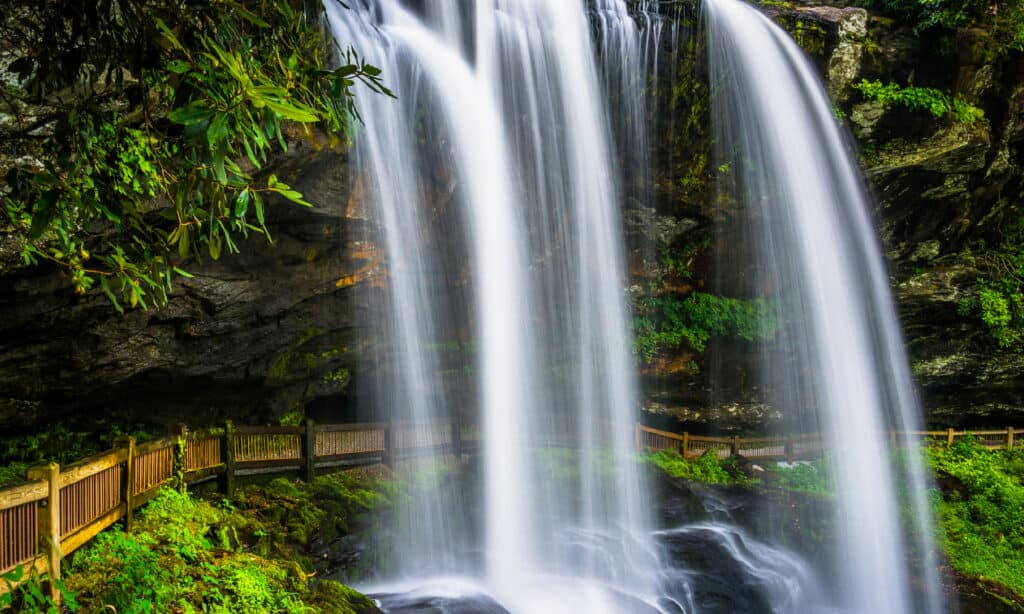
Dry Falls gets its name from the fact that you can walk behind the spray of the falls and remain dry
©iStock.com/Jon Bilous
In western North Carolina, the Cullasaja River in the Southern Blue Ridge flows out of the mountains. It has several falls along its 19-mile course from Lake Sequoyah’s spillway to the Little Tennessee River. Dropping about 1300 feet in a seven-and-a-half-mile section known as the Cullasaja Gorge, there are three waterfalls.
The region is incredibly diverse and home to many species, including snakes. Lurking along the shore and in the river are common watersnakes, eastern garter snakes, eastern rat snakes, the occasional racer, venomous timber rattlesnakes, and copperheads.
5. Yadkin River

©Andy Fogelsonger/Shutterstock.com
Flowing for over 200 miles, the Yadkin River is one of the longest rivers in North Carolina. It’s perfect for paddling a canoe or kayak and has gorgeous scenic views along the way.
The river was culturally important to Native Americans for over 10,000 years and is home to tons of wildlife. As far as snakes, there are about a dozen species living in and around the Yadkin River, including common watersnakes, garter snakes, and eastern rat snakes. Along the shore, in the leaf-litter lurk Dekay’s brownsnakes, ringneck snakes, and the occasional North American racer. You may find a copperhead or timber rattlesnake too, but they’re not as common in western North Carolina.
Summary
North Carolina’s rivers make terrific homes for thousands of species from the very large to the very small. We went looking for the rivers with the biggest snake populations, but are these North Carolina rivers snake-infested? That’s for you to decide.
| River Name | Snakes Found | |
|---|---|---|
| 1. | Crabtree Creek | Common watersnake, eastern ratsnake, garter snakes, venomous copperheads, queen snake. |
| 2. | Black River | Cottonmouths, plain-bellied watersnake, brown watersnake, banded watersnake, racers, rat snakes, and venomous copperheads. |
| 3. | Alligator River | Brown watersnake, midland watersnake, and plain-bellied watersnake, cottonmouths. |
| 4. | Cullasaja River | Common watersnakes, eastern garter snakes, eastern rat snakes, racers, venomous timber rattlesnakes, and copperheads. |
| 5. | Yadkin River | Common watersnake, common gartersnake, eastern rat snake, Dekay’s brownsnake, ringneck snakes, racers. |
Other Animals in North Carolina Rivers
Aside from snakes, North Carolina rivers are wildlife havens. From the giant alligators that lurk beneath the water to huge birds of prey soaring above the water, these ecosystems are diverse.
Marbled Salamander (Ambystoma opacum)
This salamander doesn’t live in the water but needs areas that flood seasonally for reproduction. As rivers swell in the spring, this is perfect for marbled salamanders to lay their eggs in secluded spots. While the adults don’t live in the water, juveniles need the water to live and breathe.
Marbled salamanders are more common in central North Carolina but can be found in any forested region in the state with a water source. They’re only about four inches long from snout to tail and have bold black and cream or white bands.
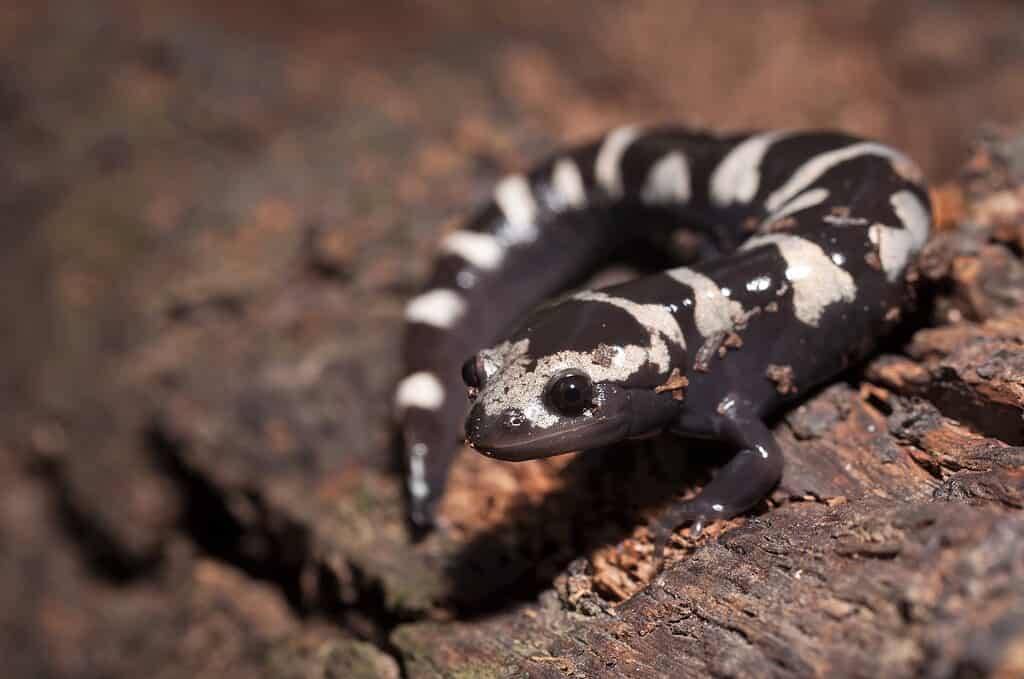
Adult marbled salamanders don’t live in the water, but they lay their eggs in flood zones.
©Mike Wilhelm/Shutterstock.com
Osprey (Pandion haliaetus)
Ospreys have wingspans reaching up to six feet and eat fish. These water-dependent birds of prey make their homes worldwide near large water bodies. However, they’ll also take up residence near wide rivers where they can catch fish — their primary food. According to the North Carolina Wildlife Foundation, they’re common sights along the Catawba River.
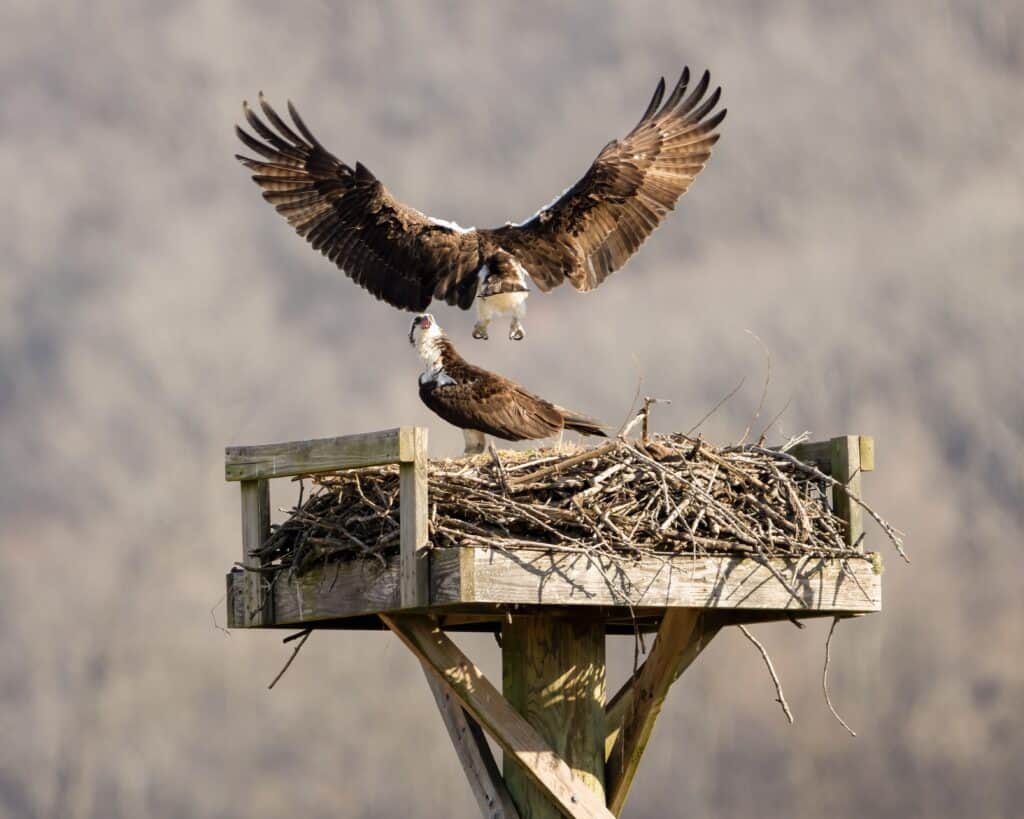
Ospreys return to the same nest site year after year.
©Wirestock Creators/Shutterstock.com
North American River Otter (Lontra canadensis)
Social with one another but secretive as a species, seeing North American river otters is a treat. Their antics make people smile and are a joy to observe.
These weasel cousins live in most of North Carolina’s rivers, specifically those with lots of fish, but they’ll also eat clams, snails, mussels, and crayfish.

River otters spend as much time in the water as they do on land.
©iStock.com/Artush
The photo featured at the top of this post is © iStock.com/Jon Bilous
Discover the "Monster" Snake 5X Bigger than an Anaconda
Every day A-Z Animals sends out some of the most incredible facts in the world from our free newsletter. Want to discover the 10 most beautiful snakes in the world, a "snake island" where you're never more than 3 feet from danger, or a "monster" snake 5X larger than an anaconda? Then sign up right now and you'll start receiving our daily newsletter absolutely free.
Thank you for reading! Have some feedback for us? Contact the AZ Animals editorial team.






